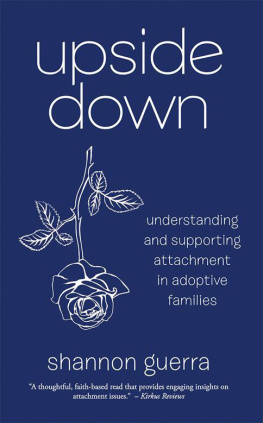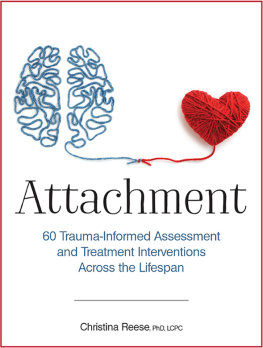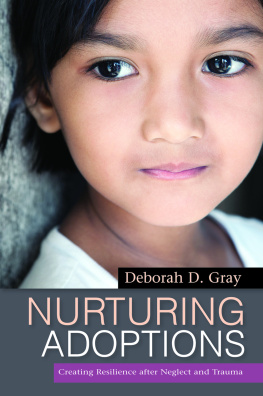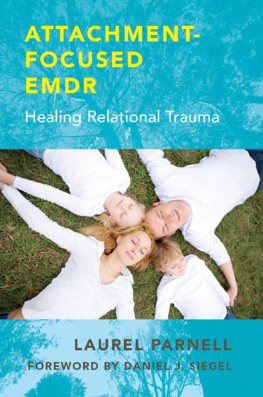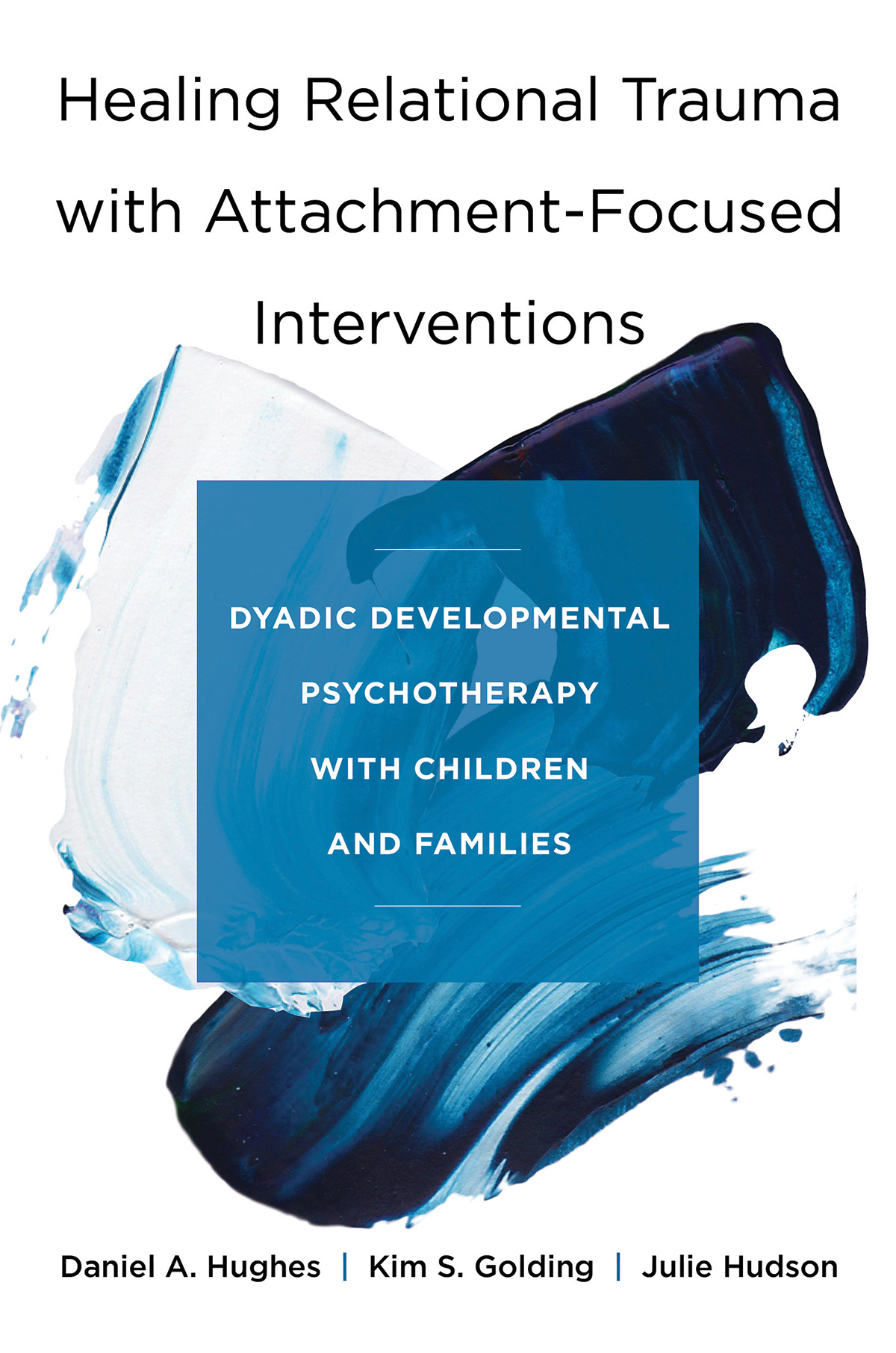Contents
Guide
Page List
Healing Relational Trauma with Attachment-Focused Interventions
HEALING RELATIONAL TRAUMA WITH ATTACHMENT-FOCUSED INTERVENTIONS
Dyadic Developmental Psychotherapy with Children and Families
DANIEL A. HUGHES
KIM S. GOLDING
JULIE HUDSON
W. W. Norton & Company
Independent Publishers Since 1923
New York London
CONTENTS
After nourishment, shelter, and companionship, stories are the thing that we need most in the world.
Philip Pullman
For most of her first 4 years, Sarah had seldom been in the mind and heart of anyone. The absence of such a relationship was her trauma. As a result, her mind and heart had not developed well and were not integrated into a sense of self that was coherent.
Sarah was now a 9-year-old adopted girl who was born in Eastern Europe, abandoned by her mother as an infant, raised in an orphanage until she was 4 years old, and then adopted by a couple from the United States. It was a loving family with an adopted son who was 4 years older than Sarah and doing quite well. But Sarah had much difficulty living in a loving family. In the 5 years since she came to live with them, she was angry, controlling, and increasingly violent, especially toward her adoptive mother, Marie. Her violence led to a broken leg for Marie when Sarah pushed her down the stairs. Many interventions for Sarah and her family were tried without success. For the safety of all concerned, Sarah was placed in a residential program where the principles of intervention were based on an understanding of attachment and developmental trauma.
Her dyadic developmental psychotherapy (DDP) therapist, Kathleen, had been seeing her in therapy over the 4 months since she entered the program. One of Sarahs two attachment aids, Tina, was also present during the therapy sessions. During this session, Sarah complained to Tina about something that she did not like at the cottage and then became angry with Kathleen for trying to start a conversation about it. More often than not, Sarah simply ignored Kathleen when Kathleen tried to engage her. It seemed to Tina that no matter what Sarah did, Kathleen would accept it and then continue the conversation or start a new one with another invitation to become engaged. Sessions similar to this one had occurred again and again in the previous 4 months, with Sarah being very challenging and rejecting and Kathleen being open to Sarahs experience, accepting it and trying to understand a bit more about Sarahs experiences. Kathleen didnt become defensive or move into lecturing or problem solving, always remaining open and engaged with whatever Sarah brought up.
When Sarah refused to join her in a conversation, Kathleen might talk with Tina or even talk to herself about Sarah, always with an attitude of acceptance, mixed with a bit of curiosity about what Sarah might be thinking or empathy about some hard times that she recently had.
Sometimes Kathleens wish to help Sarah to become more cooperative and engaging made it difficult to accept her defenses. She so wanted to push Sarah into a better life! Then Kathleen would reflect a bit more, recalling the hard times that Sarah must have had during the first 4 years of her life. This invariably helped Kathleen to find compassion for Sarah, which enabled Kathleen to be patient and accept Sarah unconditionally again.
At one point in this session, Tina mentioned that Sarah often complained about life at the cottage, much like her adoptive mother had said that Sarah complained about life at home. Tina added that she thought that Sarahs mother was a good person who cared for Sarah and was committed to her. Sarah ignored this and looked out the window.
Inhibiting a wish to tell Sarah that her mother was in fact someone who did care for her and whom she could trust, Kathleen instead quietly began talking with Tina. She hoped that by not addressing Sarah directly, Sarah would have little to be angry about. Though silent, Sarah often seemed to listen, maybe even think a bit about what Kathleen was saying. That hope kept Kathleen fully present as she spoke with Tina. In a soft and rhythmic manner, Kathleen spoke of Sarahs story:
KATHLEEN: I dont think that Sarah feels safe with mothers, Tina. She might not be sure if she wants a relationship with her mom. When she was a baby, it seems that her first mother didnt take very good care of her. She left her at a police station and never came back. Sarah was sick, thin, very dirty, and sore. She was in a hospital for 2 months and then went to the orphanage. She lived there for almost 3 yearsand I dont know if you know this, Tinathere were no mothers in the orphanage! No mother to get to know her, hold and play with her, care for her in a special way. Then when she met her adoptive mother, she really didnt trust her. She was used to taking care of herself so she didnt know what to do when her mother would do things for her and with her. And shed really get angry when her mother would say no to her. She thought that she said no because she was mean and wanted her to be unhappy! So, I understand, Tina, why Sarah is not too happy in the cottage and wasnt too happy at home. She never had a mother she trusted who could help her to have a life that would show her what happiness was.
A minute or two of silence followed, with Sarah still staring out the window. Then, in a quiet voice, Sarah said, I miss my mother.
Just as quietly Kathleen said to Tina, Tell her how you feel, Tina, about her missing her mother.
Tina thought for a moment and then said, I feel sad for you Sarah, because youre missing your mother and shes not here.
As Tina spoke, Sarah looked at Tina and noticed a few tears in her eyes. Sarah said, Youre crying!
Then Tina saw that Sarahs face looked vulnerable, and she felt a few more tears.
Yes, Sarah, I had tears because youre missing your mother and shes not here. And now I have some more tears because I think youve been missing a mother all of your life. At that, Sarah leaned against Tina, who embraced her. Sarah cried and Tina stroked her hair. After a few minutes, Sarah asked Tina when her mother was coming for a visit. Tina replied that shed be there over the weekend. Sarah smiled and put her head on Tinas shoulder.
Over the previous 4 months, Sarah had gradually begun to notice that she existed in the minds and hearts of Kathleen and Tina. She noticed because Kathleen and Tina repeatedly invited Sarah to join them in synchronized nonverbalverbal conversations, invitations that sometimes she accepted but more often declined. When Kathleen told Tina the aspect of Sarahs story about not often experiencing a mother, Sarah not only noticed her presence in their minds and hearts but also allowed herself to truly experience them intersubjectively. Afterward, Tina thought about this conversation and about how part of her had wanted Kathleen to join her in a lecture about how the rules at the cottage were fair and Sarah was being unreasonable. Tina felt grateful that Kathleen had found a way to help her to see and connect with Sarahs vulnerability and pain underneath the angry deflecting kid she had come to know.
That weekend, Sarah seemed a bit different. She wanted to talk with her mother more. She seemed more relaxed, and Tina sensed a new connection between them. Sarah seemed determined to figure out how to have a mother. She was beginning to question her old story that she was not lovable while becoming aware of a new story that she might be able to have a mother who loved her, who saw something good in her. And slowly, step by step, she was able to do it. She was able to find a way into her mothers mind and heart and discover herself there. Within this relationship, she was able to finally begin to develop her own mind and heart.



